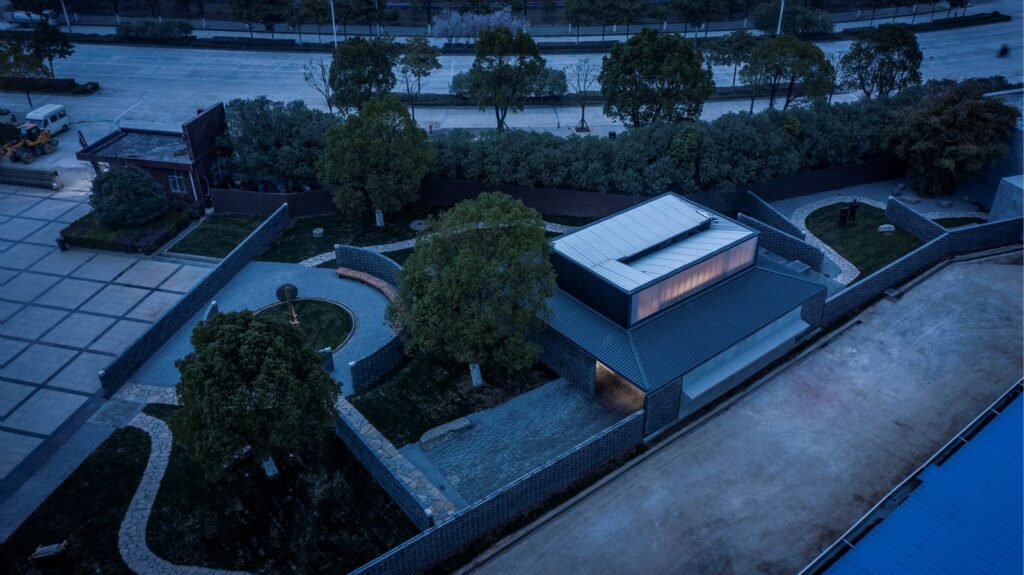Shayang Rapeseed Museum by LUO Studio

Zuo Jing and his team invited Approach Architecture Studio and completed a series of regional design practices of space, exhibitions, and products related to the local agriculture industry of Jingmen, Hubei Province. It is after such work as a preface, LUO Studio was invited by Zuo Jing to transform the existing space of the Shayang Rapeseed Museum and renovated its site.
Existing problems and transformation strategies
Not as a single building, the original Shayang Rapeseed Museum comprised three architectural spaces – the Main Building, the Auxiliary Building (currently a Museum Shop), and Hui Xiang Fang (Archives). The original site of the museum grew extensively and randomly without a plan. To solve the problem of the overall disconnection of the exhibition space, the design team rearranged the interior and exterior in a connected and continuous way.
In addition to adding the necessary functions, plus repairing the anti-seepage and heat insulation, the designers organically organized the interior spatial relations and the various irregular landscapes at the corners between the buildings to sort out the small gardens and courtyards with different function types related to each other. Thus, integrating the unrelated fragments and the internal space into an organic and continuous unity.
Curating the order of exhibition route — Reorganizing site plan
The contours of the factory wall and the urban road landscape established a set of unrelated non-parallel polylines, between which the Archives had an abnormally staggered and negative spatial boundary. It is crucial to rationally organize the area between the Main Building and the Museum Shop to coordinate and revitalize these fragmented spatial boundaries. Using the visiting route of people as a clue, the existing landscape elements such as the bamboo grove, celebrity statues, large camphor trees, and enormous round mills are integrated into the design of this narrow site.
A 1.4-meter tall masonry screen wall is constructed at the turning point to divide and establish multiple interconnected square spaces, weakening the sense of narrowness of the original site. A master plan (including exhibition route and layout logic) is formed based on the visiting order; Starting from the bamboo courtyard after exiting the Main Building, to the celebrity statue garden. Entering the Archives to its exhibition hall, and exit to the central green space. Followed by the camphor tree bench area, end at the round mill for sitting and viewing”.
Establish big through small — The enclosure walls inseret inwards, and the furniture extends outwards
Through positive space strategies, the narrow passage adjacent to the factory was redesigned as part of the Archives’ interior space. This spatial maneuver allowed the internal exhibition space to be expanded as a result. The increasingly leisurely circulation for visiting is accompanied by naturally generated entrances for turning and retreating.
Entering the exhibition is now ceremonial, and the two narrow interfering visiting routes are now united into one. This is one way of establishing big through small. Another way is by installing a bench on what was originally a windowsill, that bridges the internal to external. Here is the turning point of the visiting route. Utilized as a resting and reading space, provided with books and information. . From a visual perspective, this continuous bench turns the outdoor lawn into a continuation of the internal space, giving a visual sense of broadness to the originally cramped space.
The new and the old — structural presentation and spatial memory
From a unified point of view, whether adding new or removing old, is to serve the exhibition better. Such as the added new continuous display stands, top lighting, resting bench, or the retained old exhibition walls, and window bookshelves. From a structural perspective, this is a deconstructive removal for exhibition, where the non-load-bearing wall is partially demolished according to the needs of the display, and a section of the structural roof slab is removed for the natural skylight.
A vivid presentation — exhibition and natural light
The original building had a flat roof with leakage and poor heat insulation. Hence the new steel frame roof was installed on the original concrete structure which solved the leakage and thermal insulation problem through the cavity layer of the erection. While using the height difference of the sloped roof to facilitate roof drainage, the skylights are created so that the indoor public space can maintain good lighting conditions even without artificial lights.
In addition to the natural light from the rooftop, a narrow slit for natural lighting behind the display niches complements artificial lighting. While the constant artificial light maintains and guarantees the essential illumination of exhibited documents, images, and objects, the natural light makes the display more vivid, a metaphor in line with the growth of natural crops represented by rapeseed.
Afterword
Liu Houli, Fu Tingdong, Wang Hanzhong, Guan Chunyun, and Li Peiwu, the five representative figures in the scientific research of rapeseed in China, are the pioneers, founders, breeding experts, cultivation experts, quality and safety scientists of rapeseed science. The hard work of the researchers has promoted the continuous high-level development of scientific research on rapeseed in China and maintained the technical level of hybrid rapeseed breeding in China at the forefront of the world.
The Archives focus on these five outstanding scientists and display their scientific research work and achievements through precious materials and documents such as graphic records, field reports, research notes, photographs, books, and papers. In addition, the archives also collect books, journals, and picture books related to rapeseed research from around the world, which are open to scholars and the public. Source by LUO Studio.
Location: Qilin Avenue, Shayang Economic Development Zone, Jingmen City, Hubei Province, China
Architect: LUO studio
Design Team: Luo Yujie, Cao Yutao, Liang Jiahui, Lu Zhuojian
Construction Firm: Hubei Agricultural Valley Construction and Development Co., Ltd.
Owner: Shayang People’s Government, Hubei Agricultural Valley Industrial Group Co., Ltd.
Building Area: 147.82 m2 after renovation
Construction Period: December 2022 – March 2023
Photographs: Jin Weiqi, Courtesy of LUO Studio





